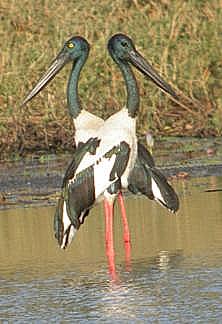Black-necked stork
| Black-necked Stork | |
|---|---|

| |
| Female with yellow and male with dark iris | |
| Scientific classification | |
| Kingdom: | |
| Phylum: | |
| Class: | |
| Order: | |
| Family: | |
| Genus: | |
| Species: | E. asiaticus
|
| Binomial name | |
| Ephippiorhynchus asiaticus Latham, 1790
| |

| |
The Black-necked Stork, Ephippiorhynchus asiaticus is a large wading bird in the stork family Ciconiidae. It is a widespread species, which is a resident breeder in southern Asia and Australasia, from India east to New Guinea and the northern half of Australia. In Australia, it is also given the common name Jabiru in Australia. Despite similarities in appearance, the stork of this name in the Americas belongs to a different genus.


The Black-necked Stork is a quite large bird, typically 130-150 cm (51-60 inches) tall with a 230 cm (91 inches) wingspan. The average weight is around 4100 grams. It is spectacularly plumaged. The head, neck, wing bar and tail are jet black, with the rest of the plumage white. The massive bill is black and the legs are bright red. Sexes are identical except that the female has a yellow iris, while the male's is brown. Juveniles are mainly light brown with a white belly and dark legs.
Like most storks, the Black-necked Stork flies with the neck outstretched, not retracted like a heron.
The Black-necked Stork breeds in marshes and other wetlands in tropical lowland. It builds a stick nest in trees, laying three to five eggs. It often forms small colonies. The diet consists mainly of fish, frogs and large insects. Small mammals, reptiles and small birds are also taken. The Black-necked Storks are extremely sensitive to environmental changes like water pollution, habitat destruction and human disruption around breeding sites. It is evaluated as Near Threatened on the IUCN Red List of Threatened Species and Endangered in the Australian state of New South Wales at the southern tip of its range.
Range
It is a widespread species, which is a resident breeder in southern Asia and Australasia, from India east to New Guinea and the northern half of Australia.
References
- Template:IUCN2008 Database entry includes a brief justification of why this species is near threatened.
- Birds of India by Grimmett, Inskipp and Inskipp, ISBN 0-691-04910-6
External links
- ARKive - images and movies of the Black-necked Stork (Ephippiorhynchus asiaticus)
- BirdLife Species Factsheet
Gallery
-
A Black-necked Stork in Perth Zoo
- IUCN Red List near threatened species
- Ephippiorhynchus
- Birds of Asia
- Birds of Pakistan
- Birds of Australia
- Birds of India
- Birds of Bangladesh
- Birds of Bhutan
- Birds of Cambodia
- Birds of Indonesia
- Birds of Laos
- Birds of Burma
- Birds of Nepal
- Birds of Papua New Guinea
- Birds of Sri Lanka
- Birds of Thailand
- Birds of Southeast Asia
- Birds of Western Australia
- Megafauna of Eurasia
- Megafauna of Africa
- Megafauna of Australia





